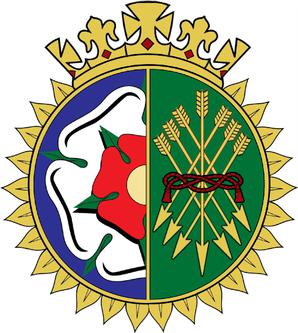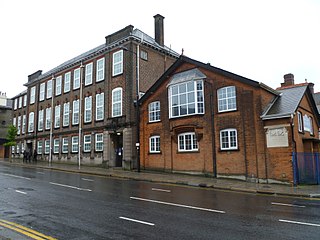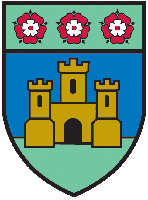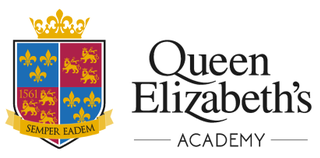
St. Olave's Grammar School is a selective secondary school for boys in Orpington, Greater London, England. Founded by royal charter in 1571, the school occupied several sites in Southwark, before establishing a location on Tooley Street in 1893. It moved to the suburb of Orpington in 1968, and has admitted girls to its sixth form since 1998.

Faversham is a market town in Kent, England, 8 miles (13 km) from Sittingbourne, 48 miles (77 km) from London and 10 miles (16 km) from Canterbury, next to the Swale, a strip of sea separating mainland Kent from the Isle of Sheppey in the Thames Estuary. It is close to the A2, which follows an ancient British trackway which was used by the Romans and the Anglo-Saxons, and known as Watling Street. The name is of Old English origin, meaning "the metal-worker's village".

The Royal Grammar School Worcester is an eleven-eighteen mixed, private day school and sixth form in Worcester, Worcestershire, England. Founded before 1291, it is one of the oldest British independent day schools.

Faversham Abbey was a Cluniac style monastery immediately to the north-east of the town of Faversham, in north Kent, England.

Queen Elizabeth's Grammar School (QEGS) is a co-educational state-funded comprehensive free school in Blackburn, Lancashire, England. Founded in 1509 as a boys' school, it is now a co-educational all-through free school with over 1200 students from ages 4 to 18. Pupils come from a very wide geographical area, from Bolton to the south and to Colne in the east. It consists of an Infant School, Junior School, Senior School and Sixth Form.

Caistor Grammar School is a selective school with academy status in the English town of Caistor in the county of Lincolnshire, England. The school was founded in 1630. It has since grown to be one of the most respected and highest performing schools in the East Midlands. The school has been awarded specialist sports and humanities status. The school attracts students from not only the town of Caistor, but also several surrounding settlements, including Grimsby, Brigg and Market Rasen. The current Headteacher is Shona Buck, who took up the position in September 2022, becoming the school's 28th head. Caistor Grammar was ranked first in Lincolnshire at both GCSE and A Level results in 2017. The school was ranked first at GCSE in 2018 and first at A level and GCSE in 2019. In the 2017 Times newspaper league tables it is in the top ten mixed state schools in the country. The school was named Sunday Times Parent Power State Secondary School of the Year 2018 in November 2017 and was the named the top school in the East Midlands by the Sunday Times in November 2019. It was also named school of the decade in the East Midlands in 2020.

Queen Mary's Grammar School (QMGS) is a boys' grammar school with academy status located on Sutton Road, Walsall, England, about a mile from the town centre and one of the oldest schools in the country. The sixth form is coeducational.

The Royal Latin School (RLS) is a co-educational grammar school in Buckingham, England. It has continually existed for over six hundred years; receiving a Royal Charter in this time and moving premises three times. In September 2011 the school became an academy. It takes children from the age of 11 through to the age of 18 and has over 1260 pupils, including a sixth form of 390 pupils. Every year it takes in 174 pupils, either those who passed the 11+ or were qualified by a Selection Review panel. It maintains a staff of just over 160. In September 2003 the school was designated by the Department for Education and Skills (DfES) as a specialist school in science. It was successfully re-designated in 2007 and achieved a second specialism as a training school.

Queen Elizabeth's Girls' School is a high performing non-selective girls' school with academy status for ages 11 to 18, in Barnet, London, England.

Queen Elizabeth Grammar School (QEGS) is an independent, public school for boys in Wakefield, West Yorkshire, England. The school was founded by Royal Charter of Queen Elizabeth I in 1591 at the request of leading citizens in Wakefield 75 in total and some of whom formed the first governing body.

Queen Elizabeth's Grammar School, Horncastle, is a co-educational grammar school with academy status in Horncastle, Lincolnshire, England. In 2009, there were 877 pupils, of whom 271 were in the sixth form.
Lincolnshire is one of the few counties within the UK that still uses the eleven-plus to decide who may attend grammar school, in common with Buckinghamshire and Kent.

Queen Elizabeth's Grammar School, Alford (QEGS) is a selective, co-educational, academy status Grammar School and Sixth Form in Alford, Lincolnshire, England. In 2021, the school held 544 pupils.

Queen Elizabeth's High School is a mixed grammar school in Gainsborough, Lincolnshire, England. The school, established in 1983, but with a timeline to 1589, is an amalgamation of the previous Gainsborough High School and Queen Elizabeth's Grammar School.

Queen Elizabeth Grammar School (QEGS) is a coeducational selective grammar school in Penrith, Cumbria, England. The school currently has approximately 830 pupils. The current headteacher is David Marchant, who took over in September 2022. The headteacher from September 2004 to August 2015 was Chris Kirkup who was seceded by Paul Buckland from September 2016.
Landau Forte Academy QEMS is an 11-16 secondary school with academy status located to the north of Tamworth, a market town in Staffordshire in the Midlands north of Birmingham. It is often known simply as QEMS . Since 1 September 2011, the school has been owned and operated by the Landau Forte Charitable Trust, after being transferred from the Staffordshire LA control.

Queen Elizabeth's School (QEGS) is a non-selective academy school for 11- to 18-year-olds in the town of Ashbourne, Derbyshire, England. In the academic year 2009–10, there were 1,396 pupils on roll.

Pitsford School, established 1989, is a co-educational, 3-18 independent school in Pitsford, Northamptonshire. Originally called Northamptonshire Grammar School, the school changed its name to Pitsford School in September 2011. Pitsford School is run by the Northamptonshire Independent Grammar School Charity Trust, set up on 27 July 1998. The trust was registered with the Charity Commission in August 1988 to promote and provide for the advancement of education. On 6 September 1989, the school opened with 47 boys admitted across three year groups, Y7-9. The founding Headmaster was Malcolm Tozer, the current headmaster is Craig Walker.

The Abbey School is a non-selective secondary school in the town of Faversham in Kent, United Kingdom. Founded with the amalgamation of Ethelbert Road Boys School and Lady Capel School for Girls in 1983, the school consists of 1056 pupils from the ages of 11–19. The school became an academy in August 2011 and joined The Howard Academy Trust on April 1, 2023

Queen Elizabeth's Academy is a co-educational Church of England secondary school and sixth form located in Mansfield in the English county of Nottinghamshire.





















